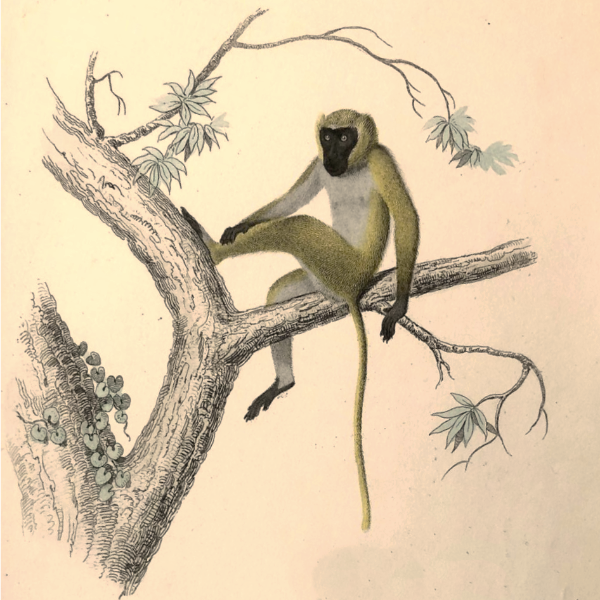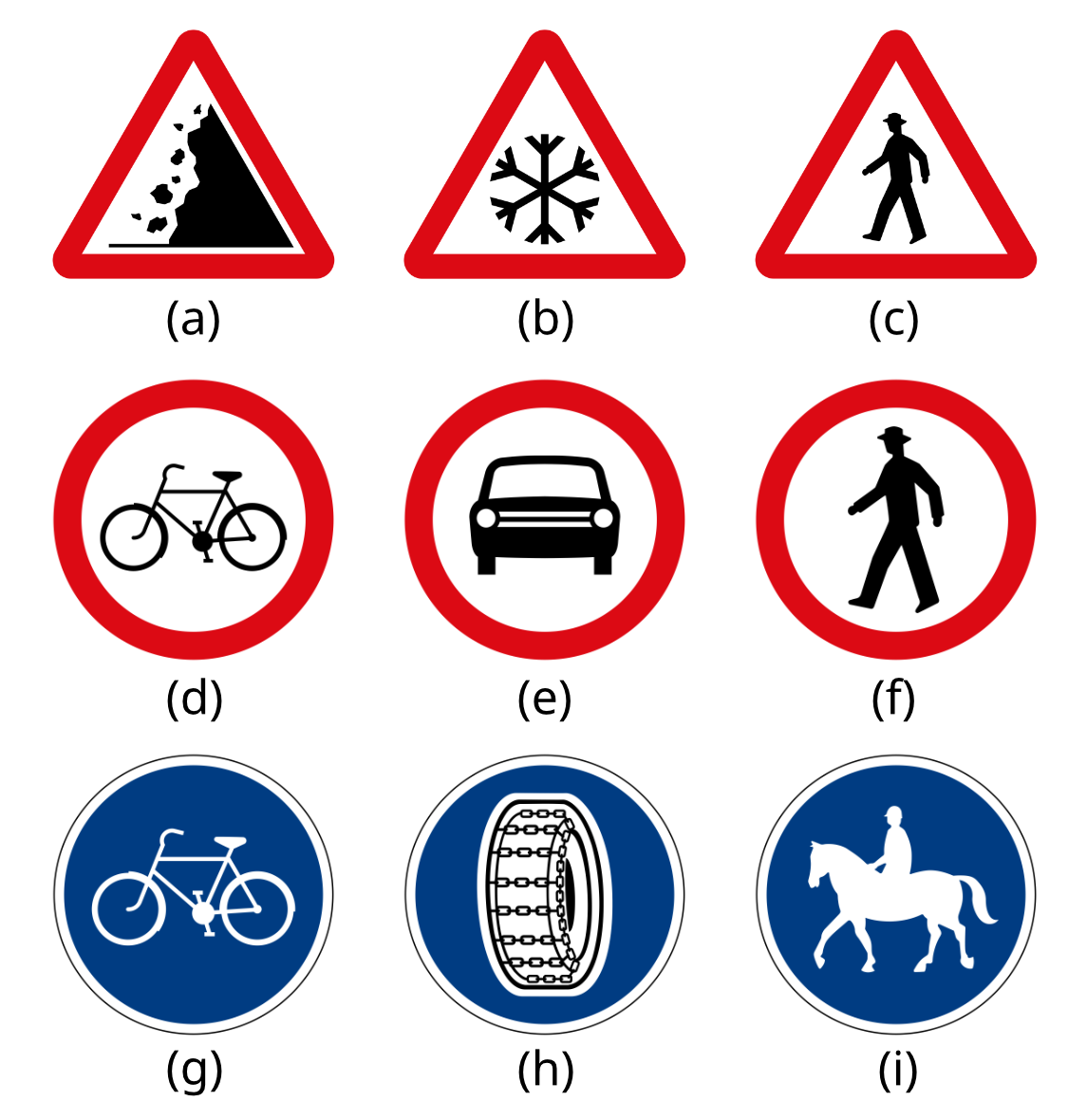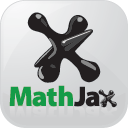Think of some other traffic signs illustrating the meanings discussed here.
Section 2.4 More on form
In Section 2.1, we discussed the fact that linguistic signs are based on arbitrary associations between form and meaning and the fact that this property makes human languages very powerful, as it does not limit us to communicating about things we can imitate in sound or gesture
But arbitrariness alone is not enough — even a system consisting of arbitrary signs is too restricted to serve the functions of human languages. In order to serve these functions, languages need a large vocabulary. By a very conservative estimate, an average language user uses four to five thousand different words in their daily life. This is already quite a lot, but in order to deal with issues beyond our daily routines, we have an even larger vocabulary: language users know between 20 000 and 50 000 words by the time they are twenty, and they continue learning new words throughout their lives. This poses a problem: we need to have a way of creating such a large number of distinct linguistic forms, and arbitrariness alone does not provide a way of doing so.
Subsection Size limits in communication systems
Let us look at a very simple communication system — that used by vervet monkeys (shown in Figure 2.4.1). Vervet monkeys can produce three different calls — one that sounds a bit like a single quack from a duck (a short, relatively high-pitched ka, often referred to as a “chirp” or a “bark”), one that sounds a bit like a choppy uh-oh (referred to as “rraup”), and one that sounds a bit like k-k-k-k-k (referred to as “chutter”).

A monkey with a black face and greyish-white fur sitting on a branch.
They use these three sounds to warn each other of their three main predators — they quack/bark when they see a leopard, causing other monkeys to move up into the trees, they rraup when they see an eagle, causing other monkeys to take cover under bushes or dense parts of the canopy and look up, and they chutter when they see a snake, causing other monkeys to stand up or move into low branches and scan the ground around them. These form-meaning associations are arbitrary and have to be learned by young vervet monkeys. This system serves its purpose, but given its low upper limit on the number of possible “words”, it cannot do more than just this.
Imagine a spoken human language where every meaning is associated with a single distinctive vocalization — for example, TREE would be associated with a “t” sound, COOKIE with a “k” sound, CUCKOO with a “u” sound, HEALTH INSURANCE with a “h” sound, and so on. In such a language, like in the vervet-monkey alarm call system, the number of possible signs would be limited by the number of different speech sounds its users can produce and distinguish. It is not known exactly what that number is for humans, but we can get a rough idea by looking at the number of speech sounds used in existing human languages: here, the upper limit seems to be around 160 — the Khoisan language !Xóõ — which holds the world record for the largest number of speech sounds observed in any human language — has 130 consonants and 28 vowels. To be on the safe side, let us double that number and assume that humans can potentially produce and distinguish 320 speech sounds.
Our hypothetical language would thus be able to express 320 different meanings. This is much better than vervet monkeys have to make do with, but it is a far cry from the vocabulary size of actual human languages. Recall that a 20-year-old knows 35000 words on average — more a hundred times the number of different sounds we are able to produce and distinguish according to our very generous estimate.
In other words, there is a huge discrepancy between the number of ideas humans need to express and the number of sounds that they have at their disposal for doing so.
Subsection Two levels of organization
Human languages solve this problem using a simple but ingenious trick that no other extant animal species — and perhaps no other animal species in the history of life on earth — has ever hit upon: by creating two independent systems working together. One system — called phonology — uses a relatively small set of meaningless speech sounds (for most languages, between twenty and forty) and combines them into larger meaningless sequences (we will look at this system in detail in Chapter 5 and Chapter 6). The other system — called morphology/syntax — attaches meanings to these sequences and combines them into a potentially infinite number of larger meaningful sequences (words, phrases, sentences, etc.). Following the French linguist André Martinet (1908–1999), this property of human languages is sometimes referred to as double articulation, with morpho-syntax referred to as the first articulation and phonology as the second articulation. This use of the word articulation is somewhat unusual, so other linguists refer to it as dual patterning. We will use the more transparent phrase “two levels of (linguistic) organization”.
Consider the words tree, cookie, cuckoo and hoodie — they all mean completely different things, yet cookie, cuckoo and hoodie share the same first vowel (the first two even share the same first syllable beginning and ending in the k sound), and tree, cookie and hoodie share the same final vowel. This is possible because the u sound, the k sound and the ee sound do not have any meaning of their own.
A sign system with two levels of organization is vastly more powerful than our fictive 320-word language discussed above. Imagine a language with ten speech sounds, five vowels and five consonants, and a very simple syllable structure where all syllables consist of a single consonant followed by a vowel. Such a language would be simpler than any actual human language — the record for the smallest number of speech sounds is held by Rotokas, a North Bougainville language spoken in Papua New Guinea, which, however, has more syllable than just consonant-vowel; conversely, Mba, a Ubangian language spoken in the DR Kongo, has just that single syllable type but a much larger set of speech sounds). Even so, this language would allow us to create 25 (5 x 5) different syllables (beating vervet monkeys by a factor of eight), 625 (25 x 25) sequences of two syllables (almost twice as many as our generous estimate of the total number of speech sounds), 15625 (253) sequences of three syllables (more than three times the number of different words we use in everyday situations).
As simple as the trick with two levels of organization sounds, it is very much a unique property of human languages. Even other sign systems created by humans are not systematically organized in this way. Consider, again, the case of traffic signs. Figure Figure 2.4.2 shows nine traffic signs (in one of the forms laid down in the Vienna Convention on Road Signs and Signals, the signs may look different in your country).

Nine traffic signs. First row: three white triangles with red border, one with a stylized image of rocks falling off a mountain side, one with a stylized image of a snowflake, one with a stylized silhouette of a man from the side. Second row, three white circles with red borders, one with a stylized image of a bicylce, one with a car, one with the same silhouette of a man seen in the first row. Third row: three blue circles with white images, one with a bicycle, one with a tire with a tire chain, one of a sihouette of a rider on a horse.
Clearly, these signs are complex — the signs for (a) ‘warning of falling rocks’, (b) ‘warning of icy road conditions’ and (c) ‘warning of pedestrians’ all have a triangular shape and a red border, the signs for (d) ‘no bicycles’, (e) ‘no cars’ and (e) ‘no pedestrians’ all have a circular shape and a red border, and the signs for ‘obligatory use of bicycle path’, ‘obligatory use of tire chains’ and ‘obligatory use of riding track’ are all circular and blue. In addition, some of the stylized images on the signs repeat across signs with different shapes and colors: the pedestrian in (c) and (f) and the bicycle in (d) and (g). We might think that there are two levels of organization here: one of meaningless colors and shapes combining in various ways and one attaching meaning to these combinations.
However, a closer look shows that this is not true — all elements in the system have meaning: the triangular shape means ‘warning’, the circle means ‘regulation’. The red border means ‘avoid what is on the picture inside the border’ the blue background means ‘do what is on the picture’ (these are rough paraphrases, of course). The combination of ‘warning’ and ‘avoid’ means ‘make sure you don’t come into conflict (with what is on the picture)’, the combination of ‘regulation’ and ‘avoid’ means ‘don’t do (what is on the picture)’, the combination of ‘regulation’ and ‘do’ means ‘you must do (what is on the picture)’.
Question 2.4.3.
Thus, while traffic signs are complex, combining both arbitrary and iconic elements, all these elements are meaningful, so they have a single level or organisation. They have a morphology/syntax, but they do not have a phonology.
Subsection
CC-BY-NC-SA 4.0. Written by Anatol Stefanowitsch
